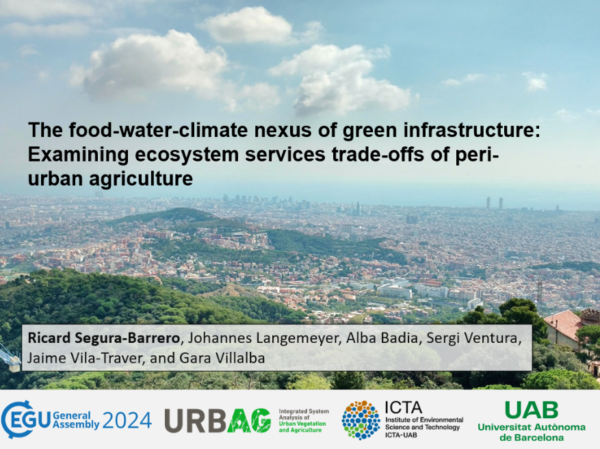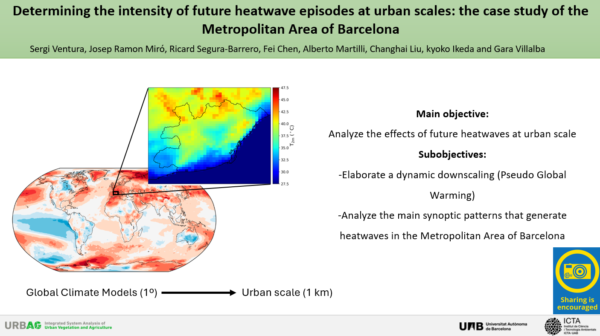URBAG participation at EGU24
2 May 2024URBAG researchers took part in the EGU’s annual General Assembly, EGU24, which was held in Vienna, Austria. The conference boasted over 20,979 registered participants, with 18,388 attendees coming from 116 countries to contribute their work during the week-long event from April 15th to 19th, 2024.
During the conference, two projects from URBAG were presented by Ricard Segura-Barrero and Sergi Ventura. Both presentations were part of the platform for Early Career Scientists (ECS). Ricard Segura presented the first one in the session titled “Urban climate, urban biometeorology, and science tools for cities”, while Sergi Ventura presented the second one in the session titled “Regional to local climate change, processes, impacts, and extremes”.
Presentation by Ricard Segura-Barrero et al.
Emission reduction, heat mitigation, and improved access to water and food provision are increasingly critical challenges for urban areas in the context of global climate change adaptation and mitigation. The revival of local agricultural production is often lauded as a potential nature-based solution. However, an expansion of peri-urban agriculture (peri-UA) may entail significant trade-offs in the ecosystem services it provides.
This study explores the impacts on the food-water-climate nexus of different scenarios of peri-urban agricultural expansion in a semi-arid, Mediterranean climate, addressing local food provision, freshwater use, local temperature regulation, global climate change mitigation, and the trade-offs thereof. Examining four theoretical land-use scenarios in the Metropolitan Area of Barcelona, the study integrates estimates of food provision and irrigation water requirements based on georeferenced urban metabolism approach with the local atmosphere and biogenic carbon balance estimates produced through the combination of an atmospheric model with a satellite and meteorological-driven biosphere model.
Our study reveals that a 31.12 % (+17.27 km2) and 115.08 % (+64.25 km2) increase in the current peri-UA in the AMB, achieved by replacing natural non-forested and forest areas, results in an increase in local food production of 24.0 % (+16503 tons year-1) and 85.8 % (+58940 tons year-1), respectively. However, it would also increase the irrigation water requirements by 10.0 % (+3.2 hm3) and 43.5 % (+14.1 hm3), respectively. The analysis of the midday/midafternoon temperatures during a summer hot month reveals that peri-UA especially when it is irrigated can potentially reduce near-surface temperatures up to 0.7 °C with respect to a current scenario, however the air cooling affects principally located in rural regions with lower population density, while temperature reductions in the densest urban areas are minimal. If an expansion of Peri-UA goes at the expense of natural non-forested and forests areas, as in the scenarios we used, it has further the potential to disrupt the regional carbon balance, impacting the net ecosystem productivity of the AMB green infrastructure and overall carbon stocks with reductions in the net ecosystem productivity of up to 18.5 % and reduce total carbon stocks by 3.3 %.
These findings, derived from an innovative and combined modelling approach, reveal significant trade-offs in ecosystem services associated with an expansion of peri-urban agriculture. It is likely that similar trade-offs would be observed with other nature-based solutions strategies. An integrated understanding of these trade-offs, facilitated by nexus approaches that combine different models, appears to be a promising direction for informing land-use decision-making in the context of urban climate adaptation and mitigation.
If you are interested in reading the abstract, please follow this link.
Presentation by Sergi Ventura et al.
Given that cities concentrate more than half of the global population, it becomes crucial to assess the potential impacts of future climate change on cities. This study employs the Pseudo Global Warming (PGW) methodology to replicate recent heatwave (HW) episodes in the Metropolitan Area of Barcelona (AMB) under projected climate conditions until the year 2100. Initially, we identify all the HW events in the AMB over the past three decades (1991-2020) and simulate these HWs using the high-resolution Weather and Research Forecasting model (WRF) with the urban parameterizations BEP+BEM.
Subsequently, the HWs observed in the last 30 years are replicated under mid-century (2041-2070) and end-century (2071-2100) climate conditions based on the SSP370 scenario. This scenario considers a future where greenhouse gas emissions and temperatures consistently rise, reflecting current climatic trends and geopolitical realities, including regional conflicts. Anticipated CO2 emissions are forecasted to nearly double from present levels by the year 2100.
The contrast between recent and future HWs is examined not only in terms of temperature and relative humidity but also concerning the synoptic patterns responsible for generating HW conditions. The findings reveal a potential increase in geopotential height by up to 100 geopotential meters (gpm) by the end of the century, reaching values of up to 6050 gpm. Average maximum 2-m air temperatures are projected to rise by 2.5°C during the mid-century and 4.2°C by the end of the century. The most significant temperature anomalies (deviations from the mean temperature) are associated with persistent and stable synoptic patterns, which are projected to increase the most in frequency and intensity. The findings on relative humidity reveal a general decrease over the AMB, with a peak value of -16.2% in the west of the domain during the PGW-END.
If you are interested in reading the abstract, please follow this link.

